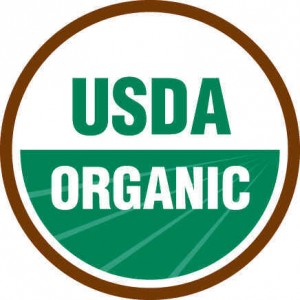 Each week, I'm able to help many thousands of families buy food for their families at 50% to 70% off at our website SavingsAngel.com. This includes organic food – which has become wildly popular over the past ten years. So popular, in fact, that big food manufacturers have jumped in the game and have offered some terrific coupons and rebates. The largest of retailers (including Walmart, Target, and Meijer) can offer hundreds of organic products – passing along some great sales in the process.
Each week, I'm able to help many thousands of families buy food for their families at 50% to 70% off at our website SavingsAngel.com. This includes organic food – which has become wildly popular over the past ten years. So popular, in fact, that big food manufacturers have jumped in the game and have offered some terrific coupons and rebates. The largest of retailers (including Walmart, Target, and Meijer) can offer hundreds of organic products – passing along some great sales in the process.
These opportunities for savings have not always been available – and I'm grateful that it has become easier to save on everything that my family eats. We love the idea of being able to buy healthier products if I can get them for less than the price of their an unhealthier variety. To read how you can use your Sunday coupons to save money on healthier foods, read my June 7th article here: https://savingsangel.com/?p=1597
While it may be exciting to get organic foods at discount prices, is it absolutely necessary to buy organic varieties when the health benefit may be minimal at best? Also, what does “organic” mean anyway?
First of all, according to the USDA, there are many terms marketed that carry no regulation whatsoever – and should not be confused with organic products that carry the USDA organic seal. Terms like “free-range,” hormone free” or “natural” have absolutely no governmental oversight – and as such, there are no standards to adhere to. Buyer beware.
The USDA offers some helpful information on labeling:
Products labeled “100 percent organic” must contain only organically produced ingredients.
Products labeled “organic” must consist of at least 95 percent organically produced ingredients. Products meeting the requirements for “100 percent organic” and “organic” may display the USDA Organic seal.
Processed products that contain at least 70 percent organic ingredients can use the phrase “made with organic ingredients” and list up to three of the organic ingredients or food groups on the principal display panel. For example, soup made with at least 70 percent organic ingredients and only organic vegetables may be labeled either “made with organic
peas, potatoes, and carrots,” or “made with organic vegetables.” The USDA Organic seal cannot be used anywhere on the package.
Processed products that contain less than 70 percent organic ingredients cannot use the term “organic” other than to identify the speciï¬c ingredients that are organically produced in the ingredients statement.
The term “organic” carries some significant marketing mojo. An example I recently saw was, “Made with organic sugar!” Is this product really healthier and worth the premium price? Marketers would like you to believe so.
The USDA, on the the hand, is clear to state that they make no claims that organic food is healthier than non-organic food. In fact, the vast majority of scientific evidence shows that non-organic foods are just as nutritious the organic varieties (speaking purely as whether a food contains nutrients). However, most consumers choose organics because of the freedom from pesticides and additives – which end up in the earth and quite likely our bodies. Is there a safe amount of these chemicals to be exposed to? The government has a safety standard that all food producers must adhere to. Beyond that safety standard it becomes a personal choice.
One resource that can be helpful for consumers when deciding what produce items to buy organic – and which are not necessary is the Environmental Working Group's “˜Dirty Dozen' and “˜Clean Fifteen.' The dirty dozen includes produce items that contain the highest levels of pesticides. This list is reviewed annually. 2011's “˜Dirty Dozen' list includes: apples, celery, strawberries, peaches, spinach, imported nectarines, imported grapes, sweet bell peppers, potatoes, domestic blueberries, lettuce, and kale/collard greens. EWG recommends buying organic versions whenever possible.
The “˜Clean Fifteen' produce items that carry the lowest levels pesticides are safer to buy non-organic: onions, sweet corn, pineapples, avocado, asparagus, sweet peas, mangoes, eggplant, domestic cantaloupe, kiwi, cabbage, watermelon, sweet potatoes, grapefruit, mushrooms.
You can learn more about the EWG's guidelines at www.ewg.org/foodnews. They emphasize that eating fruits and vegetables (even if they are the conventionally grown non-organic type) are more important to good health than an organic label slapped on a box of processed ‘organic' food.
If you'd like to afford more healthy fruits and vegetables in your diet, you can use your Sunday coupons and SavingsAngel.com to save hundreds of dollars a month on everything else you buy on a regular basis.
The easiest way to cut your grocery bill in half is through using manufacturers coupons combined with the best sales at local stores. Normally, this takes a lot of work to create a winning shopping list for your family. Each week, SavingsAngel.com combines over 2,000 products on sale at local grocery and drug stores with their enormous database of manufacturer coupons ““ which are found in your Sunday paper and throughout the Internet. This combination results in access to over 300 products each week for 50% off or better. Here are a few examples of deals that are available until Saturday at midnight. Please look in Tuesday's Grand Rapids Press each week for tips on how you can easily start cutting your grocery bill!
Josh Elledge is the Chief Executive “Angel” of SavingsAngel, Inc. ““ launched from his Holland, Michigan home in January 2007. A husband and father of three, he now appears each week on Fox 35 Orlando, in the Grand Rapids Press, and a number of radio stations across the country teaching families how to cut their grocery bill in half using the Internet. Elledge created the technology found on SavingsAngel.com through the need to save his own family's money. Successfully able to cut his own grocery bill from $600 a month to less than $300 a month, his message has reached hundreds of thousands of families. SavingsAngel.com is now growing rapidly throughout the country. You can watch a short video at SavingsAngel.com that will explain more information about how to cut your own grocery bill in half with the help of SavingsAngel.com.


